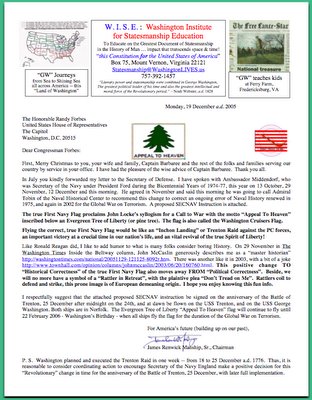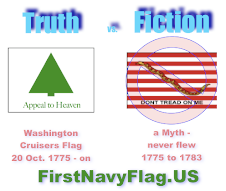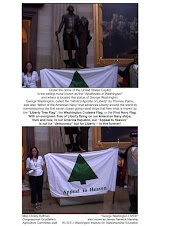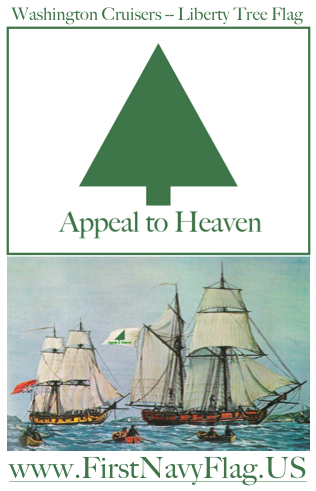Extracts from 22 Dec 2005 email reply to RADM Tobin of NAVHISTCEN email:
Dear Admiral Tobin,
Thank you for your reply email.
I am not surprised that you are aware of my interest in the Navy Jacks, or that you have been briefed by your staff - several times…
…It was a "revelation" to me to learn that the Rattlesnake Jack was not a true Revolution era flag.
Well meaning, patriotic people did NOT know in 1975, or even 2002, that the Rattlesnake Jack flag is a lie -- but we do NOW.
"NOW is the time for all good men to come to the aid of their country..."
Ambassador Middendorf has told me that he sees the error and believes that the Navy Jack should be changed from the Rattlesnake Jack.
Won't you join him, a man of impressive historical knowledge and understanding?
You write, the Fleet is quite content with the decision. Yet would the Fleet be content if they knew that the flag were not true? If they knew the Navy "let fly a lie"?
There is the old saying "A lie can get half way around the world before the Truth gets its boots on." Winston Churchill said, "...before the Truth gets its pants on."
You also write, Our role here is to confirm the history of the versions of the Jack and we have done that.
But have we? Have we done so fully? With other daily demands on our time, have we been diligent in serving the Truth?
When I met with Dr. Crawford on 11 October 2005, he said, "They did not consult with us."
From further research, I perceive his statement meant that the Bicentennial Navy Jack project officers did not consult with the Early History Branch, because I know from talking with CDR Berryman nearby in Virginia Beach who worked on the project in 1975 that he and others from the Secretary's office worked with people at the Naval Historical Center.
The reality is that at that time pretty much everyone took the Rattlesnake flag as "the gospel truth". I surely did. Did you?
Now we know better. There is considerable doubt the Rattlesnake Flag EVER flew on a Continental ship, or any Revolution era Navy ship.
Thursday, December 22, 2005
Extracts from 22 Dec 2005 email reply to RADM Tobin of NAVHISTCEN email:
Posted by
J R "States" Manship
at
Thursday, December 22, 2005
0
comments
![]()
![]()
Wednesday, December 21, 2005
Ambassador J. Wm. Middendorf (SecNav 1975-77) of Draft Endorsement Letter of Dec a.d. 2005

J. William Middendorf
December 2005
The Honorable Gordon R. England
Secretary of the Navy
1000 Navy Pentagon
Washington, District of Columbia 20350-1000
Dear Secretary England:
Recently it has been brought to my attention that SECNAV Instruction 10520.3 that I signed on 1 August 1975 when I served as Secretary of the Navy began a well meaning error in our Navy history. By this letter I am asking that you help correct that error.
As you know that instruction established the practice of flying as the Navy Jack Flag on our Navy ships the “Don’t Tread on Me” Rattlesnake over Stripes Flag that was believed to be the first Navy flag during the Bicentennial Years from 13 October 1975 to 31 December 1976. Based on that precedent, you signed SECNAV Instruction 10520.6.
I have recently learned that the instruction I signed was not staffed through the Naval Historical Center, and in fact, the website of that organization discounts the prevalent opinions that the Rattlesnake flag as now depicted ever flew on a Continental Navy ship, and at the least, was not the first Navy flag.
The first Navy ship commissioned was the Hannah commissioned on 2 September 1775 by Commander in Chief of all Continental forces, George Washington. His aide, Colonel Joseph Reed, wrote of the flag to be flown on the Continental ships commissioned. The design of the flag was a white field with a pine tree, or an Evergreen Tree, and the motto “Appeal To Heaven” inscribed below. The Liberty Tree where the Sons of Liberty met in Boston was chopped down in August 1775, so the “Evergreen Tree of Liberty” has much symbolism. There are many historical accounts of this flag flown on our Navy ships.
In addition, the motto is in essence a “Call to War” and derives from John Locke’s Second Treatise on Government chapter XIV “Of Prerogative”, where is written:
“to appeal to heaven…have no appeal on earth,
then they have a liberty to appeal to heaven.”
So I ask that you sign a new SECNAV Instruction that establishes the “Washington Cruisers Flag” or the “Evergreen Tree of Liberty Flag” as the First Navy Flag that is flown as the Navy Jack Flag during the Global War on Terrorism.
Respectfully,
J. William Middendorf
Posted by
J R "States" Manship
at
Wednesday, December 21, 2005
0
comments
![]()
![]()
Monday, December 19, 2005
Congressman Randy Forbes 19 Dec. a.d. 2005 letter

Monday, 19 December a.d. 2005
The Honorable Randy Forbes
United States House of Representatives
The Capitol
Washington, D.C. 20515
Dear Congressman Forbes:
First, Merry Christmas to you, your wife and family, Captain Barbaree and the rest of the folks and families serving our
country by service in your office. I have had the pleasure of the wise advice of Captain Barbaree. Thank you all.
In July you kindly forwarded my letter to the Secretary of Defense. I have spoken with Ambassador Middendorf, who
was Secretary of the Navy under President Ford during the Bicentennial Years of 1974-77, this year on 13 October, 29
November, 12 December and this morning. He agreed in November and said this morning he was going to call Admiral
Tobin of the Naval Historical Center to recommend this change to correct an ongoing error of Naval History renewed in
1975, and again in 2002 for the Global War on Terrorism. A proposed SECNAV Instruction is attached.
The true First Navy Flag proclaims John Locke’s syllogism for a Call to War with the motto “Appeal To Heaven”
inscribed below an Evergreen Tree of Liberty (or pine tree). The flag is also called the Washington Cruisers Flag.
Flying the correct, true First Navy Flag would be like an “Inchon Landing” or Trenton Raid against the PC forces,
an important victory at a crucial time in our nation’s life, and an vital revival of the true Spirit of Liberty!
Like Ronald Reagan did, I like to add humor to what is many folks consider boring History. On 29 November in The
Washington Times Inside the Beltway column, John McCaslin generously describes me as a “master historian”
http://washingtontimes.com/national/20051129-121125-8092r.htm. There was another like it in 2003, with a bit of a joke
http://www.townhall.com/opinion/columns/johnmccaslin/2003/06/20/160760.html. This positive change TO
“Historical Correctness” of the true First Navy Flag also moves away FROM “Political Correctness”. Beside, we
will no more have a symbol of a “Rattler in Retreat”, with the plaintive plea “Don’t Tread on Me”. Rattlers coil to
defend and strike, this prone image is of European demeaning origin. I hope you enjoy knowing this fun info.
I respectfully suggest that the attached proposed SECNAV instruction be signed on the anniversary of the Battle of
Trenton, 25 December after midnight on the 24th, and at dawn be flown on the USS Trenton, and on the USS George
Washington. Both ships are in Norfolk. The Evergreen Tree of Liberty “Appeal To Heaven” flag will continue to fly until
22 February 2006 - Washington’s Birthday - when all ships fly the flag for the duration of the Global War on Terrorism.
For America’s future (building up on our past),
James Renwick Manship, Sr., Chairman
P. S. Washington planned and executed the Trenton Raid in one week -- from 18 to 25 December a.d. 1776. Thus, it is
reasonable to consider coordinating action to encourage Secretary of the Navy England make a positive decision for this
“Revolutionary” change in time for the anniversary of the Battle of Trenton, 25 December, with later full implementation.
Posted by
J R "States" Manship
at
Monday, December 19, 2005
0
comments
![]()
![]()
Monday, December 12, 2005
1 page Exec. Summary of Raven Journal Article against Snake flag as First Navy Flag


Summary of "The First Navy Jack," by Peter Ansoff. It is published in Raven: A Journal of Vexillology, Vol. 11 (2004). (underline and bold added)
Page 2: “The First Navy Jack (Figure 1)” (Editor Note: Snake Over Stripes flag) “is a well-established part of American lore.” (Editor Note: More accurate than “well-established” would be to say “widely accepted” part of American lore.) … It has been an icon of the United States Navy since 1975-76, when all ships flew it to commemorate the bicentennial of the Navy and the United States…. The terrorist attacks of 11 September 2001 increased the popularity of the “rattlesnake and stripes” as a defiant symbol of national unity and resolve, both in the Navy and among the general public.”
“In fact, however, there is little evidence that his flag was flown by Commodore Hopkins in 1775, or that it even existed during the American Revolution.”
Page 9: Under the header “The Flags in the Thomas Hart Portrait”
“It appears that the naval historian Samuel Eliot Morison was correct when he made this comment: The mezzotint portrait of Esek Hopkins published in England… is a work of imagination by someone who never saw Hopkins or his ships… the flags are fantastic.”29
Page 10: “Third, 18th-century British and European illustrators often used the stretched-out “crawling rattlesnake” as a symbol of the American revolutionary cause, whereas there is no other known evidence that it was ever used on American flags.”35
Page 10: “In summary, the evidence strongly suggests that the striped rattlesnake flag depicted in the Hart engraving was not a realistic depiction of an American naval flag, any more than the palm tree in his Arnold portrait accurately depicted the flora of Canada.”
Page 12: “Nevertheless, the Hart image of Hopkins and its many descendants are standard illustrations in books and websites dealing with the Continental Navy and the Revolutionary War. 43 Generations of flag historians have assumed them to be authentic, and have built upon them a legend of the First Navy Jack –
an historic flag that never was.”
The legend of the Snake Over Stripes was step by step furthered by several books:
1830 Biography of John Paul Jones by Robert Sands
1839 History of the Navy of the United States of America by James Fenimore Cooper
1850 Pictorial Field-Book of the Revolution by Benson Lossing
1864 The History of our Flag by Ferdinand Sarmiento
1872 History of the Flag of the United States of America by RADM George Preble
1880 The Flag of the United States and Other National Flags by RADM George Preble
In his 1880 book Admiral Preble tried to correct his previous error in the 1872 book about the existence of the Snake Over Stripes flag. But the snake flag myth survived!
Page 20: Dr. Whitney Smith, founder and director of the Flag Research Center, has said of Preble’s work:
“…Original research is time-consuming and demanding and it’s easy to assume that published sources are correct and can be trusted. Those who have written books and articles or have created web sites about American flags have for the most part relied on work done by Preble. As a result there is a constant repetition of misinformation that gives certain designs the impression of accuracy.” 64
Posted by
J R "States" Manship
at
Monday, December 12, 2005
0
comments
![]()
![]()
Saturday, December 03, 2005
Navy Historian William Bell Clark, and Dennis Conrad...
Posted by
J R "States" Manship
at
Saturday, December 03, 2005
0
comments
![]()
![]()













